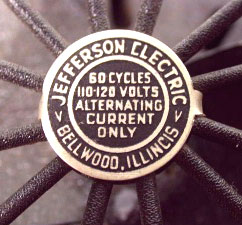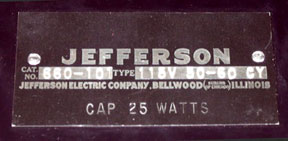Jiffy-Jeff
and Monitor Washers plus a Deluxe Fan
By Roger Russell
These pages are copyrighted
No portion of this site may be reproduced in whole or in part
without written permission of the author.
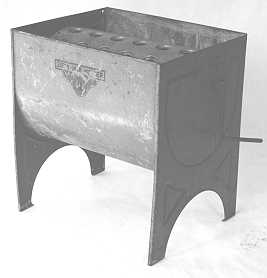 Of all the Jefferson Electric products I have seen,
this is the most unusual one. There are two different versions of the washer.
One has a hand crank and the other is motor driven. The Chicago
address on the label indicates it may have been made before 1931 when Jefferson moved
to Bellwood, IL. Several pictures are in black & white for
clarity. Any comments or additions are welcome.
Of all the Jefferson Electric products I have seen,
this is the most unusual one. There are two different versions of the washer.
One has a hand crank and the other is motor driven. The Chicago
address on the label indicates it may have been made before 1931 when Jefferson moved
to Bellwood, IL. Several pictures are in black & white for
clarity. Any comments or additions are welcome.
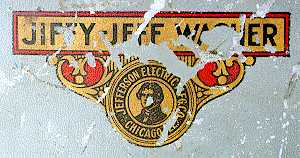 A competitor, Monitor Equipment Corporation, also made
clocks and washers. The clocks are based on patents of a common inventor.
A competitor, Monitor Equipment Corporation, also made
clocks and washers. The clocks are based on patents of a common inventor.
The antique dealer I bought it from thought it was a salesman's sample. A reader of this page thought it was obviously for washing women's smaller garments.
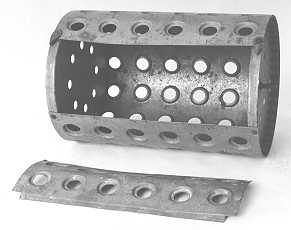 All the parts appear to be made of galvanized steel.
The washer is 9-3/4" high, 9" wide and 7-1/4" deep. The words
"WATER LINE" and a solid line below it are on the inside of
the washer basin. The line is about 2-7/8" from the top. The basin is
5-5/8" deep. The 5-1/2" diameter drum is 8-1/4 " wide. It is
perforated with 12 rows of 6 holes that have a diameter of 1/2". The holes
are pushed in or countersunk 1/8" deep and 3/4" in diameter. Metal
All the parts appear to be made of galvanized steel.
The washer is 9-3/4" high, 9" wide and 7-1/4" deep. The words
"WATER LINE" and a solid line below it are on the inside of
the washer basin. The line is about 2-7/8" from the top. The basin is
5-5/8" deep. The 5-1/2" diameter drum is 8-1/4 " wide. It is
perforated with 12 rows of 6 holes that have a diameter of 1/2". The holes
are pushed in or countersunk 1/8" deep and 3/4" in diameter. Metal 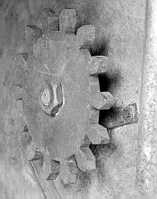 locking tabs on either side of the drum can be rotated
aside and a section of the drum containing 2 rows of holes can be removed.
Material to be washed can then be put inside the drum.
locking tabs on either side of the drum can be rotated
aside and a section of the drum containing 2 rows of holes can be removed.
Material to be washed can then be put inside the drum.
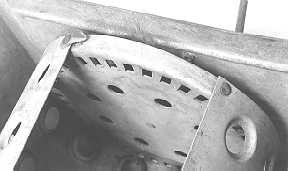 One side of the drum has 40 slots that mesh with a
14-tooth gear mounted in the washer frame. This gear is connected to a handle
that turns the drum. Eight additional holes are at each end of the drum. These
are 3/8" in diameter and spaced equally in a circle 2-3/4" in
diameter. A 3/16" diameter shaft at each end of the drum fits into a
groove at either side of the basin. The entire drum assembly can be easily
removed by lifting up and out.
One side of the drum has 40 slots that mesh with a
14-tooth gear mounted in the washer frame. This gear is connected to a handle
that turns the drum. Eight additional holes are at each end of the drum. These
are 3/8" in diameter and spaced equally in a circle 2-3/4" in
diameter. A 3/16" diameter shaft at each end of the drum fits into a
groove at either side of the basin. The entire drum assembly can be easily
removed by lifting up and out.
![]()
Motorized Version
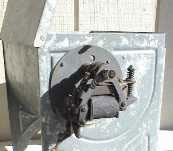
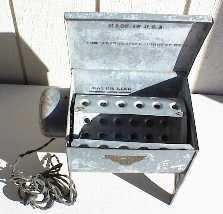 A motorized version has also been found. The washer is
the same except the crank has been replaced with a motor and gears. A flat top
cover can be closed when the washer is in use. In the picture, the drum cover
is open.
A motorized version has also been found. The washer is
the same except the crank has been replaced with a motor and gears. A flat top
cover can be closed when the washer is in use. In the picture, the drum cover
is open.
The writing on the inside of the lid says Made in USA. Under that it says For Alternating Current Only. Inside the washer it says Water Fill Line and under it is the line. The coiled power cord can be seen at the bottom left. The motor is shown at the left with the cover removed.
![]()
Monitor Washer, Rex Cole and Boots Boy
A book titled Rex Cole on Salesmanship by Rex Cole in collaboration with C. D. Frazer was published by B. C. Forbes Publishing Company, 120 Fifth Avenue, New York City in 1935 (253 pages). It's a guide on how to be a good salesman. "It is based principally upon the experience of Rex Cole and members of his organization." In the introduction it states:
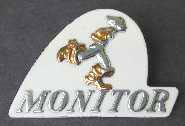 "On the hood of his car and at his farm, on the
chinaware, the table linen, the door mats, the flag pole and every other nearly
appropriate place, he has neatly affixed his emblem--The Seven League Boots
Boy. Remember the legend? The boy whose boots helped him step clear over all
obstacles, over depressions, from mountain to mountain, seven leagues at a
time--toward his objective. Here is a silent sermon for salesmen who falter
along on the ground and do not see high or far enough. This is one of the first
lessons: "Hitch your wagon to a star"; or better still, as Justice
Holmes suggested, steer your course by a star that you have never seen."
"On the hood of his car and at his farm, on the
chinaware, the table linen, the door mats, the flag pole and every other nearly
appropriate place, he has neatly affixed his emblem--The Seven League Boots
Boy. Remember the legend? The boy whose boots helped him step clear over all
obstacles, over depressions, from mountain to mountain, seven leagues at a
time--toward his objective. Here is a silent sermon for salesmen who falter
along on the ground and do not see high or far enough. This is one of the first
lessons: "Hitch your wagon to a star"; or better still, as Justice
Holmes suggested, steer your course by a star that you have never seen."

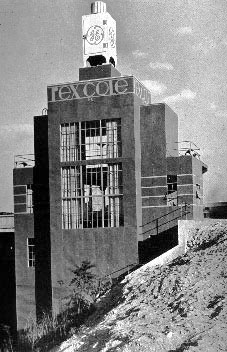 Rex Cole Inc. was the New York distributor for
General Electric refrigerators. Remember the ones that had the cylindrical
compressor on the top? Starting in 1928, Raymond Hood designed four Rex Cole
showroom buildings. They were all different but had a modernist approach
typical of the period of "stylistic ferment." An article about the
buildings was published in American Architect, December 1931. The buildings
were located at 6528-6530 Fourth Ave., Bay Ridge, Brooklyn, 2392 Grand Concourse in The Bronx, 137-155 Northern Blvd in Flushing, Queens and at the gateway to the Ridge section of Brooklyn. One
building had a very large GE symbol etched into the transparent glass so that
at night, when lit from behind, the facade became a glowing advertisement.
Another building had a large replica of the GE refrigerator at the top.
Rex Cole Inc. was the New York distributor for
General Electric refrigerators. Remember the ones that had the cylindrical
compressor on the top? Starting in 1928, Raymond Hood designed four Rex Cole
showroom buildings. They were all different but had a modernist approach
typical of the period of "stylistic ferment." An article about the
buildings was published in American Architect, December 1931. The buildings
were located at 6528-6530 Fourth Ave., Bay Ridge, Brooklyn, 2392 Grand Concourse in The Bronx, 137-155 Northern Blvd in Flushing, Queens and at the gateway to the Ridge section of Brooklyn. One
building had a very large GE symbol etched into the transparent glass so that
at night, when lit from behind, the facade became a glowing advertisement.
Another building had a large replica of the GE refrigerator at the top.
One of the products was the Monitor Washer. The washer is motor driven but the wringer is hand operated. This was called the Aerator model AERW-4. It works on 115 volts 60 cycles. Monitor is listed as Monitor Home Appliances, Riverdale, NY and had a brand name of Monitor Prestomat Washer. This emblem, shown above, came from a washing machine made by the Monitor Equipment Corporation. Monitor also made several different AM radios in the 1940's.
Clocks with the figure of the Boots Boy may have been made for Rex Cole by Monitor. These were based on a patent purchased by Jefferson Electric from Leendert Prins. This is the same patent that several Jefferson clocks are based on. The Boots Boy clock is Model 5-A.
![]()
Jefferson Deluxe Fan
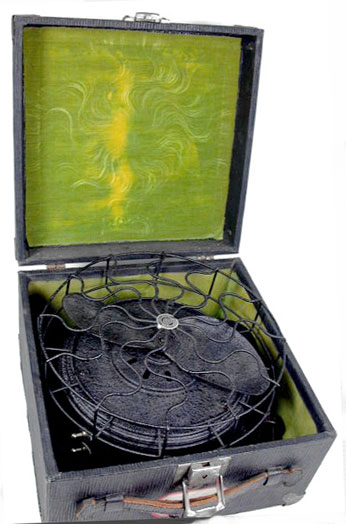 Here is another curiosity from Jefferson Electric. It
comes in a beautiful case with green velvet lining. It is made like a musical
instrument case with black leatherette and metal corners. It has a locking
latch with a key. A paper label on the case says “Electric Fan”
Here is another curiosity from Jefferson Electric. It
comes in a beautiful case with green velvet lining. It is made like a musical
instrument case with black leatherette and metal corners. It has a locking
latch with a key. A paper label on the case says “Electric Fan”
The mystery about this fan and case is why it would be sold with such a fancy case. The answer could be that it is used like the salesman sample clock case on my main Jefferson page. This may also be a salesmans case that was constructed for traveling and taken to various dealers.
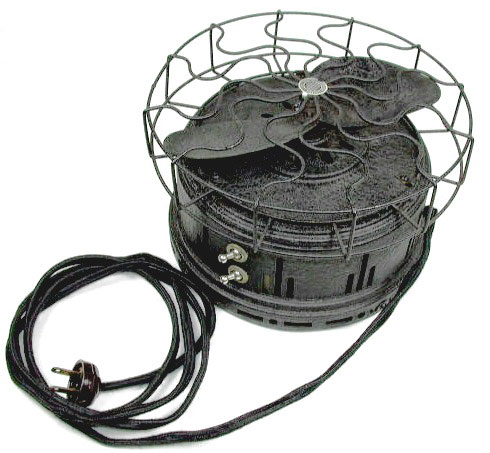 This is a pancake style fan. The base is cylindrical
with stylish piercings on the bottom step and the main body. The bottom is
7-3/4” in diameter. The wire cage is 8-3/4” and encloses a two-blade propeller.
The whole finish is in black crackle paint. The cord is covered in black cloth
with a bakelite 1940’s style plug. The housing has four rubber feet on the
bottom as well as a keyhole cutout for hanging on a wall.
This is a pancake style fan. The base is cylindrical
with stylish piercings on the bottom step and the main body. The bottom is
7-3/4” in diameter. The wire cage is 8-3/4” and encloses a two-blade propeller.
The whole finish is in black crackle paint. The cord is covered in black cloth
with a bakelite 1940’s style plug. The housing has four rubber feet on the
bottom as well as a keyhole cutout for hanging on a wall.
There are two toggle switches on the side. One switch turns on the fan that sells quietly and moves a small volume of air. The other switch apparently routes current through several turns of wire wrapped around a mesh-covered hollow tube about 4” long and 3/4” in diameter and is located inside the housing. It was supposedly used in a funeral parlor and has been suggested that the heater was used to evaporate a pleasant scent in the air for services.
The black and silver label on the bottom has a Jefferson part number of 160-101.
|
|
|
![]()
|
About This Site |
||
|
|
More text and pictures about Jefferson will be added as my research continues. Any comments, corrections, or additions are welcome. |
|
|
|
|
All
contents are copyrighted |
